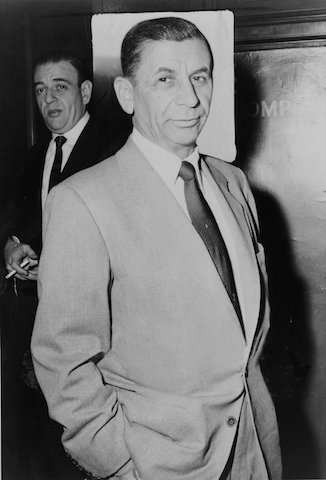
Meyer Lansky, in New York, 1958. Photo by Al Ravenna, courtesy of Library of Congress, LC-USZ62-120718
By Kathy Kuenzer
Meyer Lansky, nicknamed the “Mob’s Accountant,” was one of the most famous and financially successful gangsters in U.S. history. His gambling empire and life of organized crime inspired the characters Hyman Roth and aspects of Michael Corleone in the 1974 blockbuster movie “The Godfather Part II.” In the early 20th century he helped to develop the National Crime Syndicate in New York, whose influence spread across the nation and beyond. Yet despite his reputation as a major organized crime figure for nearly 50 years, he was never found guilty of anything more serious than illegal gambling. Before dying from lung cancer in Miami Beach, Fla., on Jan. 15, 1983, the FBI believed Lansky left behind $300 million in hidden bank accounts though none of the money was ever found. After his death, his family discovered his estate was worth about $57,000.
For many years, Lansky’s colorful life has been the subject of movies, television shows, documentaries, books and newspaper stories. Often overlooked, however, is a chapter in Lansky’s life in which he came to Council Bluffs in 1941 to open a business that would help revive the city’s economy and earn him a reputation as a respected businessman.
New York beginnings
Born to Polish-Jewish parents in Grodno, Belarus, on July 4, 1902, Maier Suchowljansky emigrated to the U.S. with his mother and brother in 1911. They joined his father, who a few years earlier had moved to New York City. Changing his name to Meyer Lansky, he would eventually find himself on the streets of Manhattan’s Lower East Side where the Italian and Jewish mafia were to become successful economic and political forces.
Lansky was a small man: as a mature adult he measured 5-feet-4-inches tall and weighed 136 pounds. Perhaps it was his diminutive stature that compelled him to use his brainpower to succeed in the world. The late syndicated columnist Victor Reisel would one day call him the “wraith-like wizard of … organized crime.” Yet, what Lansky lacked in brawn he made up for in brains, despite finishing only the eighth grade. After landing a job with a tool and die maker, he decided to supplement his income by starting a floating dice game. It was his first foray into illegal gambling.
Lansky soon became the leader of a Jewish street gang. That’s when he met another Jewish kid, Benjamin “Bugsy” Siegel, and the local Italian gang leader Charles “Lucky” Luciano. The three would later become organized crime partners.
When the U.S. enacted Prohibition in 1920, Lansky, only 18 years old, found a money-making opportunity in bootlegging. And he was good at it. Part of his success lay in his skills with numbers and, surprisingly, his honesty and integrity: He kept his word and rather than leaving a paper trail, he stored numbers in his head. At this time, he and Siegel joined forces to form the Bugs and Meyer Mob, a new gang that hired out gunmen through Murder, Inc. — Murder for Hire. Although Lansky himself never murdered anyone, he was the brains behind the operation.
TO READ THE ENTIRE STORY AND OTHER FASCINATING STORIES ABOUT IOWA HISTORY, subscribe to Iowa History Journal.
